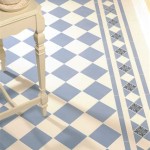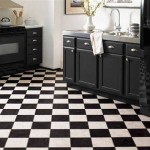Black and White Kitchen Tile Floor: A Timeless Design Choice
The black and white kitchen tile floor represents a classic and versatile design element that has remained popular for decades. Its enduring appeal lies in its ability to adapt to a variety of kitchen styles, from traditional to contemporary. This article explores the various aspects of black and white kitchen tile floors, including design options, material choices, installation considerations, and maintenance techniques.
The Enduring Appeal of Black and White
The combination of black and white offers a high contrast visual impact, creating a dynamic and engaging aesthetic. This inherent contrast makes it suitable for both small and large kitchens. In smaller spaces, the strategic use of these colors can create the illusion of spaciousness, while in larger kitchens, it can help define different zones. Beyond its aesthetic appeal, the black and white color scheme is also perceived as clean, modern, and sophisticated. Its neutrality ensures that the floor complements a wide range of cabinet colors, countertop materials, and appliance finishes. This adaptability contributes to its long-standing popularity in kitchen design.
Furthermore, the historical context of black and white flooring adds to its charm. From Victorian-era homes to Art Deco designs, black and white tile patterns have been a staple in architectural history. This rich heritage imbues the design choice with a sense of tradition and elegance. Modern interpretations of this classic scheme continue to be implemented, demonstrating its timelessness and its capacity to evolve with contemporary trends.
The simplicity of the color palette also allows for greater flexibility in decorating the rest of the kitchen. Homeowners can easily introduce pops of color through accessories, such as cookware, textiles, and artwork, without clashing with the floor's neutral base. The black and white floor serves as a blank canvas, allowing for easy updates and changes in the overall kitchen décor without requiring a major renovation.
Exploring Design Patterns and Layouts
One of the primary advantages of using black and white tile is the vast array of design patterns and layouts that can be achieved. The classic checkerboard pattern, characterized by alternating black and white squares, is a popular and visually striking option. This pattern creates a bold and graphic statement, suitable for both traditional and modern kitchens. The size of the squares can be varied to achieve different effects, with larger squares creating a more modern look and smaller squares evoking a more vintage feel.
Another option is the diagonal or diamond pattern, which involves laying the square tiles at a 45-degree angle. This pattern can help to visually expand the space and add a touch of elegance to the kitchen. The diagonal pattern also works well with different tile sizes and can be customized to create unique and interesting designs. Borders can also be incorporated to define the perimeter of the floor and add a more finished look.
Beyond the traditional checkerboard and diagonal patterns, there are numerous other design possibilities. Herringbone and chevron patterns, created using rectangular tiles, offer a more sophisticated and intricate look. These patterns can add movement and visual interest to the floor, making them a great choice for kitchens that need a focal point. Geometric patterns, such as stripes, triangles, and hexagons, can also be used to create a modern and contemporary look. These patterns can be achieved through the use of different tile shapes and sizes, as well as through the strategic placement of black and white tiles.
The size and shape of the tiles also play a crucial role in the overall design. Small mosaic tiles can be used to create intricate patterns and designs, while larger format tiles can create a more seamless and modern look. Rectangular subway tiles, arranged in a brick pattern, can add a touch of vintage charm to the kitchen. The possibilities are virtually endless, allowing homeowners to create a truly unique and personalized kitchen floor.
Furthermore, the surface finish of the tiles can also impact the overall aesthetic. Glossy tiles reflect light and can make the space feel brighter, while matte tiles offer a more subtle and understated look. Textured tiles can add depth and dimension to the floor, creating a more tactile experience. The choice of surface finish should be carefully considered based on the desired look and feel of the kitchen.
Material Choices and Considerations
Several materials are suitable for black and white kitchen tile floors, each with its own unique characteristics, advantages, and disadvantages. Ceramic tile is a popular choice due to its durability, affordability, and wide range of design options. Ceramic tiles are resistant to water, stains, and scratches, making them ideal for the high-traffic and moisture-prone environment of the kitchen. They are also relatively easy to clean and maintain.
Porcelain tile is another excellent option, offering even greater durability and water resistance than ceramic tile. Porcelain tiles are fired at higher temperatures, resulting in a denser and less porous material. This makes them highly resistant to staining and damage, even in high-traffic areas. Porcelain tiles are also available in a wide range of colors, patterns, and sizes, providing homeowners with numerous design possibilities.
Natural stone tiles, such as marble and granite, can also be used to create a luxurious and elegant black and white kitchen floor. Marble and granite are known for their natural beauty, durability, and unique veining patterns. However, natural stone tiles require more maintenance than ceramic and porcelain tiles. They are porous and susceptible to staining, so they need to be sealed regularly to protect them from damage.
Vinyl tiles are a more affordable and versatile option for black and white kitchen floors. Vinyl tiles are available in a wide range of colors, patterns, and textures, including realistic stone and wood looks. They are also water-resistant and easy to clean, making them a practical choice for the kitchen. However, vinyl tiles are not as durable as ceramic, porcelain, or natural stone tiles, and they may be more susceptible to scratches and dents.
When choosing the material for a black and white kitchen tile floor, it is important to consider factors such as budget, durability, maintenance requirements, and aesthetic preferences. Ceramic and porcelain tiles are generally the best choice for homeowners who are looking for a balance of affordability, durability, and design options. Natural stone tiles are a good choice for homeowners who are willing to invest in a more luxurious and elegant look. Vinyl tiles are a good choice for homeowners who are looking for a more affordable and low-maintenance option.
Installation and Maintenance
Proper installation is crucial to the longevity and performance of a black and white kitchen tile floor. It is generally recommended to hire a professional tile installer to ensure that the tiles are laid correctly and that the floor is properly sealed. A professional installer will have the necessary tools and experience to handle the job efficiently and effectively. However, experienced DIYers may be able to install the tiles themselves, provided they have the necessary skills and knowledge.
Before installing the tiles, it is important to prepare the subfloor properly. The subfloor should be clean, level, and free of any debris. Any cracks or imperfections in the subfloor should be repaired before laying the tiles. A cement backer board should be installed over the subfloor to provide a stable and moisture-resistant base for the tiles. This is particularly important in kitchens, where moisture levels can be high.
The tiles should be laid according to the desired pattern or layout. It is important to use a high-quality thin-set mortar to adhere the tiles to the subfloor. The tiles should be properly spaced using tile spacers to ensure consistent grout lines. After the tiles have been laid, the grout should be applied to fill the gaps between the tiles. The grout should be sealed to protect it from staining and moisture damage. The choice of grout color can also affect the overall look of the floor. A dark grout can enhance the contrast between the black and white tiles, while a light grout can create a more subtle and understated look.
Maintaining a black and white kitchen tile floor is relatively simple. Regular cleaning with a mild detergent and water is usually sufficient to keep the floor looking its best. Avoid using harsh chemicals or abrasive cleaners, as these can damage the tiles and grout. Spills should be cleaned up immediately to prevent staining. The grout should be resealed periodically to maintain its water resistance. Doormats should be placed at entrances to prevent dirt and debris from being tracked onto the floor. With proper care and maintenance, a black and white kitchen tile floor can last for many years.

Squares Stove Black

Quadrostyle Black And White Marble Checkerboard Vinyl Wall Floor Stickers Two Tone Kitchen Tile Decals Peel Stick Bathroomtile Etsy

Black And White Floors That Make A Statement Architectural Digest

Tiles For Miles Flooring

Galley Style Pantry With Black And White Harlequin Floor Tiles Transitional Kitchen

Ceramic Tile Kitchen Floor Pros Cons And Best Designs Stone

Statement Black White Tile Options

20 Black And White Kitchen Floor Ideas That Are Simply Mesmerizing

Black White Decorative Kitchen Floor Tiles Eclectic Dublin By Tilestyle Houzz

Kitchen Floor Tile Ideas 2025 Marble Systems








